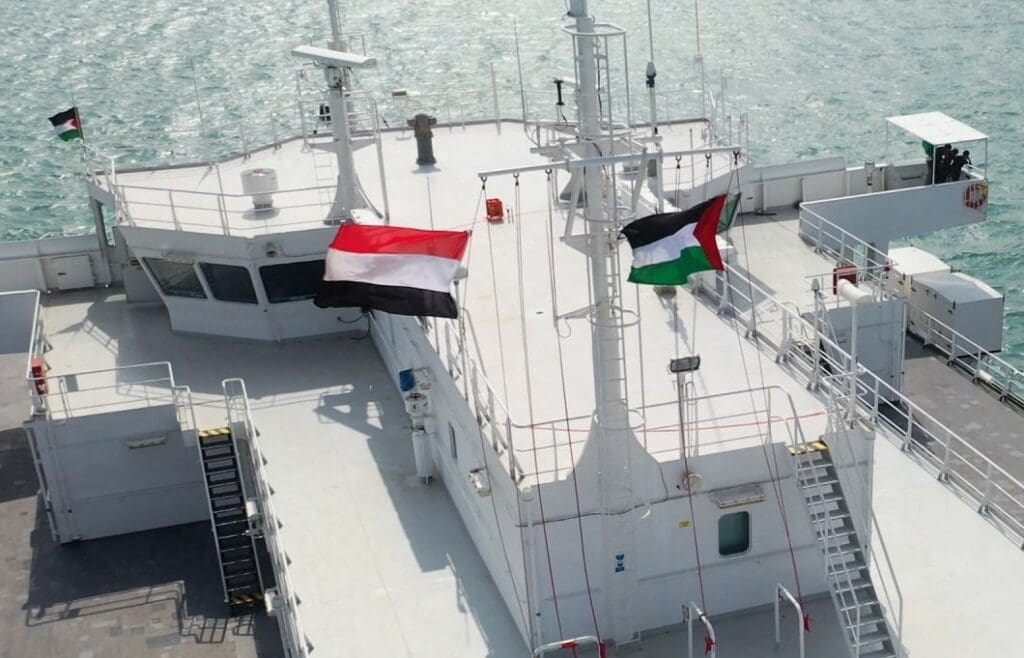Yemen’s Houthi rebels have emerged as an unlikely player in the unfolding war in the Gaza Strip. On November 19, Houthi fighters hijacked a cargo ship in the Red Sea and took its crew hostage, citing the vessel’s association with Israeli business interests. On December 3rd, they attacked two Israeli commercial ships. The group, officially known as Ansar Allah, has also launched several ballistic missiles and drone attacks on Israel since Hamas’ “Al Aqsa Flood” operation on October 7. Amid Israel’s escalating violence in Gaza, the Houthis vowed to continue targeting Israeli territory and vessels until the aggression towards Gaza ceases. So far, Israeli forces have yet to retaliate, relying on air defense systems the United States military presence in the region to neutralize threats.
While the involvement of the Houthis has surprised some observers, Yemen offers an ideal position—both politically and geographically—for the Iranian-led “axis of resistance” to target Israel without regionalizing or escalating the war on Gaza, while enabling the Houthis to reinvigorate popular support among their base without facing significant retaliation.
Houthi Motives and Strategy
Ansar Allah, founded on an ideology promoting resistance against the “forces of arrogance”—America and Israel—consistently advocates for the liberation of the al-Aqsa Mosque in Jerusalem and resistance against imperialist forces, as reflected in their slogan, “The Scream.” The group has always justified its insurrection and coup in Yemen as a component of this resistance project. Thus, when the aggression on Gaza commenced, it was an opportune moment for them to galvanize their base by reasserting their commitment to these ideological objectives.Initially, after October 7, Houthi leaders cited the lack of borders with Palestine and Saudi Arabia’s refusal to permit the transit of forces or projectiles through its territory as limitations on its ability to engage. However, their approach shifted with the onset of Israel’s ground offensive in Gaza and the perpetration of numerous massacres against civilians. Increasingly sophisticated in their military and communications strategy, the Houthis released footage of one of their helicopters hijacking the ship in the Red Sea, which spread widely on social media.
While their missiles have been largely ineffective so far, they have increased the group’s engagement with the U.S. military. American warships stationed in the Red Sea have reportedly intercepted at least five Israel-bound missiles and 16 drones over the past two months. Moreover, there is an alleged U.S. presence on the ground in Yemen that could potentially alter the Houthi calculus should they engage with the group, although the Islamic State group and Al-Qaeda in the Arabian Peninsula are the American troop’s official targets, not Ansar Allah.
The Houthis’ actions so far have primarily served to reinforce their solidarity with the Palestinian cause and the Iran-aligned “Axis of Resistance,” to regain waning popularity, and to bolster their reputation among the Yemeni and Arab populations. This move is likely to secure them regional influence, both within the “Axis of Resistence” and in the ongoing Yemeni conflict. However, a more substantial regionalization of the war would risk undermining the Houthi position and concessions extracted from Saudi Arabia during peace talks, and thus is unlikely to serve Houthi interests.
Houthi Military Capabilities
The Houthis boast a significant military arsenal, partly inherited from the Yemeni army and partly supplied by Iran. This arsenal includes advanced Iranian ballistic missiles with a range of up to 2,000 kilometers (over 1,200 miles). Additionally, they possess a vast fleet of drones with similar or longer ranges; some even have the capacity to reach Tel Aviv. These missiles and drones have been used in their recent attacks, but their effectiveness is drastically reduced by Israel’s advanced air defense systems, such as the “Iron Dome” and the long-range “Arrow 3” system, deployed in response to the Houthi attack on October 31.
Furthermore, Israel’s military bases on Eritrean islands in the southern Red Sea, near the Yemeni coast, allow for early threat detection. The United States has also bolstered its forces in the Red Sea and is providing Israel with immense military support, including two additional Iron Dome missile defense systems, further neutralizing Houthi assaults.
Thus, Yemen is well positioned geographically to stage symbolic attacks on Israel without opening a new, regionalized front. In order to have greater effect, the Houthis would need to intensify their attacks, inundating the southern Israeli city of Eilat’s airspace with missiles or drones to disrupt the defense systems and achieve their stated objectives.
Maritime-wise, the Houthis possess an arsenal with about ten different missile systems, including anti-ship ballistic missiles with a 500-kilometer range and cruise missiles reaching up to 800 kilometers. Additionally, the Houthis have naval units that have proven their prowess in the past, attacking a Saudi frigate in January 2017, targeting the Muskie MT tanker in May 2017, seizing Saudi and South Korean ships in November 2019, and striking the Israeli ship MV Helios Ray in the Gulf of Aden in February 2021.
Intervention Options and Their Consequences
The Houthis’ intervention options in Israel’s war on Gaza are geographically and militarily constrained, aiming more to halt the war than to expand it. These options include two main scenarios.
The first would be a continuation of their recent approach, launching ballistic missiles and drones at Eilat and other Israeli and U.S. targets. This strategy would also involve targeting ships in the Red Sea, as seen during the recent hijacking, but nevertheless is unlikely to impact Israel’s aggression in Gaza or alter the war’s trajectory. It may cause minimal material damage and cause ships to avoid Yemeni waters but is primarily aimed at enhancing the Houthis’ local and regional popularity.
Burnishing Ansar Allah’s reputation would serve as a lifeline amid the group’s deteriorating economic conditions and its inability to form a new government following the dismissal of the Ben Habetour government that was accused of failure and corruption over a month ago. It would also improve their standing in peace talks with Saudi Arabia, boost morale, and solidify their position in the “Axis of Resistance.” This scenario is likely, as it minimizes the risk of provoking substantial blowback and aims at halting the war rather than expanding it. However, depending on the frequency and damage incurred by these attacks, U.S. warships may be prompted to intervene to curb Houthi naval forces and conduct targeted raids under the guise of maintaining Red Sea security.
The second scenario is closing the geo-economically critical Bab al-Mandab strait to pressure Israel to cease its aggression on Gaza. While the Houthis have the military capacity to execute this option, it seems unlikely due to its unpredictable consequences. Implementing it could disrupt global energy, shipping, and trade systems. Furthermore, naval forces from various countries, including the United States, Egypt, France, and China, are protecting the Bab al-Mandab Strait and surrounding areas from piracy and sabotage. This would make the Houthis’ decision to close the strait costly. Nonetheless, the scenario remains plausible if the Gaza war continues to escalate and other parties, such as Hezbollah and Iran, become more involved.
Ultimately, the Houthis are likely to continue intermittently launching missiles and drones and targeting Israel-linked ships, to exert pressure on Israel to stop the war while simultaneously strengthening their position.


